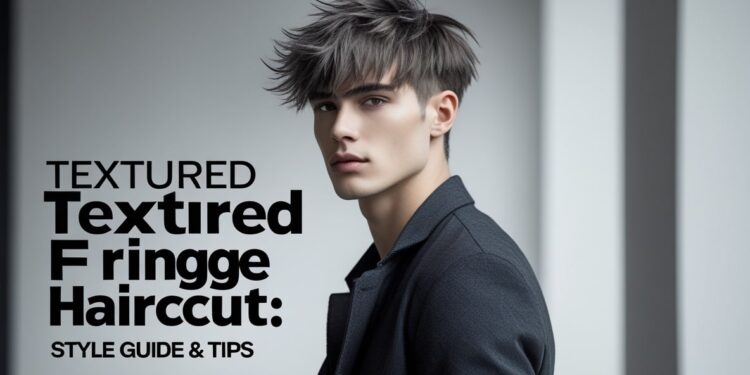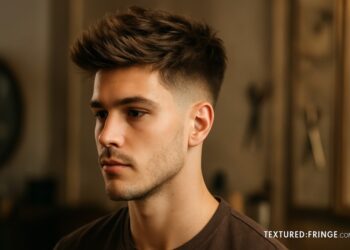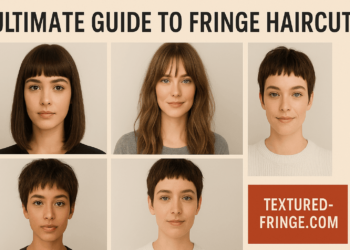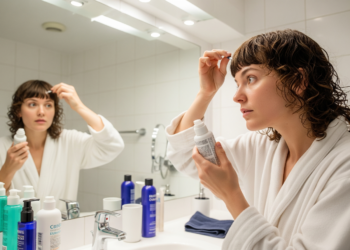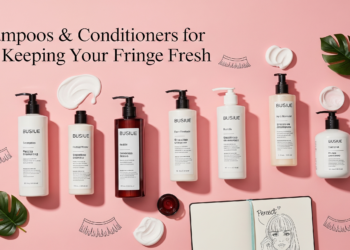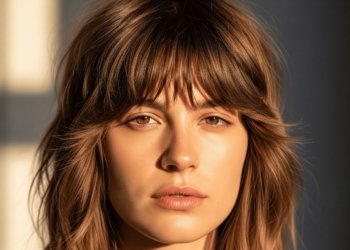Textured fringe haircuts have exploded in popularity among men looking for an easy, stylish update to their look. In hair jargon, a “fringe” is just the British term for bangs – that front portion of hair that falls on the forehead. In a textured fringe, those bangs are cut into layers or choppy, uneven ends to add intentional volume and movement. Stylists call these cuts “low-effort, high-reward” because they add shape and edge without hours of styling. What was once a niche trend (think TikTok teens) is now mainstream – even celebrities like Rami Malek have sported a short textured fringe to great effect. Whether your hair is straight, wavy, or curly, there’s a version of the fringe that can work for you. We’ll break down what a textured fringe is, who it suits, how to style and maintain it, how to ask your barber for one, and plenty of other tips.
What Is a Textured Fringe Haircut?
A textured fringe haircut simply means you have bangs (the hair over your forehead) that are cut with layers or point-cut ends for extra texture. In practice, a barber might use a razor or scissors to create choppy, broken-up ends rather than a straight-across line. For example, one tutorial describes a “wash-and-go” fringe where the bangs were razored so they fall softly just above the eyebrows with natural movement. The result is a fringe that looks piecey and full of depth, not flat or blunt. A textured fringe adds depth and dimension to the haircut, making the style look modern and edgy. In short, it’s an easy way to freshen up a haircut: instead of a flat forehead, you get a little wave of hair that frames the face and adds volume.
Face Shapes & Hair Types
A great thing about the textured fringe is its versatility. All hair types can wear it – straight, wavy, or curly hair work equally well. The secret is simply adjusting the cut and products to your texture (for example, using a curl cream or diffuser on curly hair). As for face shape, most can work with the right fringe style. Oval, square, round, and heart-shaped faces all work with a textured fringe. To maximize the effect, match the fringe length and cut to your face proportions:
- Oval faces: Extremely versatile. You can pull off most fringe styles, from classic to messy.
- Square faces: Textured fringes (especially layered or curly ones) help soften a strong jawline. A high fade with fringe can also elongate the face.
- Round faces: A choppy, messy fringe adds height at the forehead, which visually lengthens the face. (Think of “controlled chaos” – it’s flattering for round/oval shapes.)
- Heart/Diamond faces: Side-swept or wavy fringes can balance a wider forehead. A wavy fringe with a fade highlights the eyes and narrows the forehead area.
- All hair types: Straight, wavy or curly hair can wear a fringed cut. The cut should complement your natural texture – for example, curly hair might be cut longer on top so the waves form a fringe naturally.
In summary, if you have any of these common face shapes, there’s likely a fringe style that flatters you. Your barber can tailor the fringe’s thickness, length, and layering to suit your face.
Styling & Maintenance Tips
- Scrunch & Texturize: Work a small amount of sea-salt spray or lightweight mousse/cream into damp hair, then scrunch or tousle the fringe as it dries. This boosts natural texture. For straight hair, a few sprays of sea-salt will give grit and lift; for curls, a diffuser on low heat helps set the wave.
- Blow-dry with lift: When blow-drying, point the nozzle at the roots and lift the hair upwards. This builds volume at the front. For curly hair, always use a diffuser to encourage curl definition without frizz.
- Use matte products: A matte clay, paste, or styling wax gives flexible hold without shine. After styling, run your fingers through the fringe rather than combing – this breaks up any stiffness. Skip heavy gels or stiff pomades, which can flatten the fringe.
- Minimal product: Remember less is more. Only a dime-sized amount of product is usually enough. Too much product will weigh the fringe down.
- Shampoo sparingly: Only wash your hair 2–3 times a week. Over-washing strips natural oils and can make a fringe look limp. On no-wash days, you can lightly spritz the roots or apply a bit more sea-salt spray to refresh the texture.
- Regular trims: Keep the fringe sharp by trimming every 3–4 weeks. Even if the sides grow out, maintaining the fringe length prevents it from falling into your eyes and losing its shape. A quick trim at the neckline or sides will keep the overall haircut crisp.
Following these tips will keep your fringe looking intentional and neat. In short: wash less, trim often, use a diffuser/spray on damp hair, and style with light, matte products.
How to Ask Your Barber
Communicating clearly with your barber is key. Don’t worry about knowing a ton of technical terms – simple phrases and examples work best. Here are some tips:
- Use clear phrases: Try something like “I’d like a textured fringe with natural movement in the front.” Or say “Add choppy layers on top for a relaxed look.”
- Bring photos: Show the barber front and side photos of the exact style you have in mind. A picture can communicate the cut and texture much better than words alone.
- Specify details: Tell them how long you want the fringe (e.g. “just above the eyebrows” or “mid-forehead”) and what you’d like on the sides. Do you want a skin fade, a taper, or just a gentle taper on the sides?
- Use key terms: Words like “messy,” “choppy,” or “point-cut ends” signal texture. For instance, you can say “point-cut the ends of the fringe” to ensure the barber layers the tips.
- Be ready to listen: A skilled barber may suggest slight adjustments for your hair type. But having a clear picture in mind – and on your phone – helps a lot.
By combining simple phrases with visual references, you’ll get exactly the textured fringe you want.
Popular Variations
There are many cool spins on the textured fringe. Here are a few styles and how they differ:
Classic Cropped Fringe
A classic textured fringe is neat and timeless. It features soft, subtle layers that naturally sweep over the forehead. The bangs are usually cut just above the brows and blend into slightly tapered sides. This style works great on straight to slightly wavy hair and suits oval or square faces. It’s low-key – you only need to run a dab of pomade or clay through it with your fingers to hold it in place. In essence, it’s a “no-fuss” fringe that looks tidy but still has that bit of texture.
Messy/Tousled Fringe
For an effortlessly cool vibe, go with a messy, choppy fringe. This cut uses uneven, broken layers throughout the bangs to create instant volume and movement. The result is a deliberately “just rolled out of bed” look – a bit rebellious yet controlled. It’s especially flattering on round or oval faces, as the extra height at the front helps elongate the face. Styling is simple: apply sea-salt spray or a matte paste to damp hair, then scrunch the fringe upward. Let some strands fall naturally for that lived-in texture.
Curly Textured Fringe
Curly or wavy hair can really amp up a fringe. Here, the stylist shapes the natural curls into a defined fringe that sits lightly over the forehead. A curly textured fringe keeps hair volume while taming bulk – perfect for guys with thick curls. It’s an especially good choice if you have a square or heart-shaped face, since the curls soften sharp angles. To maintain it, use a curl cream or light mousse to enhance definition without frizz. The end effect is full, lively bangs that play up your hair’s natural wave.
Fade or Undercut Fringes
Pairing a textured fringe with a fade or undercut is extremely popular. For example, a skin fade fringe keeps the sides buzzed close while leaving length on top. This high-contrast look really draws the eye upward to the textured fringe. A wavy fringe with a skin fade highlights your cheekbones and works for oval, heart, or diamond faces. Similarly, a high fade with a forward-swept fringe sharpens the jawline and gives a modern twist. You can even opt for a disconnected undercut – skin off the sides and full texture on top – for a bold statement. In all cases, the idea is that the sides are clean-shaven or tapered so the textured fringe stands out even more.
Celebrity Inspiration
Looking for real-life examples? Many style-savvy celebs have rocked fringes. For instance, actor Rami Malek famously wears a short, texturized fringe. He had his stylist cut his bangs square from temple to temple, which made his triangular face appear wider and more balanced. It’s a good reminder: a well-cut fringe can reshape a face. Other stars (from heartthrob actors to pop musicians) have worn their own versions of a fringe, helping to normalize this look in pop culture. You don’t need to copy anyone exactly – but browsing celebrity photos can give you a sense of the many ways to wear a fringe, from ultra-neat to wildly tousled.
Frequently Asked Questions
Is a textured fringe suitable for my hair type?
Yes – straight, wavy, or curly hair can all pull it off. The barber will tailor the cut and styling to your texture.
Is this style high-maintenance?
Not really. Most textured fringes are low-effort. With regular trims and light styling, you’re good to go.
What face shapes work best with a fringe?
Oval, square, round, and heart-shaped faces all work. Your barber can advise the best fringe style for your shape.
How do I keep my fringe from falling flat?
Use a texturizing spray or light matte clay, and blow-dry your fringe upwards at the roots for lift.
How often should I trim my fringe?
Every 3–4 weeks to maintain length and keep the texture crisp.
Can a textured fringe help hide thinning hair?
Yes! It adds volume and can cleverly cover up a receding hairline or thinner spots.
